Books
The Microorganisms in Foods series are intended to address food safety challenges that impact international food trade. The first book in the series addressed microbial methods and provided recommendations to aid in harmonisation of testing results.
The second book was the first publication to comprehensively address statistically based sampling pans for foods. Microbial ecology of foods, Hazard Analysis and Critical Control Point (HACCP) principles, as well as survival and growth characteristics of microbial pathogens have been addressed in this series.
The Commission periodically updates its books. For example, the 2nd edition of Microorganisms in Foods 7 was published in 2018.
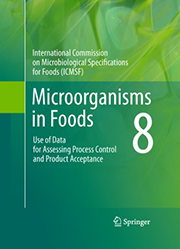
Microorganisms in Foods 8
Use of Data for Assessing Process Control and Product Acceptance
Provides practical guidance on appropriate testing of food processing environments, processing lines, shelf life and finished product to enhance the safety and microbiological quality of the food supply. Microorganisms in Foods 8 is intended for anyone using microbiological testing or engaged in setting microbiological criteria including government, food processors and the customers they supply. This book provides actionable information for food quality assurance professionals, food microbiologists, food technologist, veterinarians, public health workers and regulatory officials. Springer. 1st edition, 2011, ISBN 978-1-4419-9373-1. Available from Springer. An errata sheet for Book 8 – PDF 94KB is available. Translations are available in Spanish, Portuguese, Chinese and, Japanese.
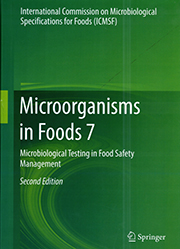
Microorganisms in Foods 7
Microbiological Testing in Food Safety Management
The 2nd edition of Microorganisms in Foods 7 published by Springer in 2018, updated and expanded on. This book describes the role of microbiological testing in modern food safety management systems. It explores how risk assessment and risk management can be used to establish goals – known as “tolerable levels of risk” or “food safety objectives” – for use in controlling foodborne illness and provides guidelines for establishing effective management systems to control specific hazards in foods. The first edition was published by Kluwer Academic/Plenum Publishers, 2002. ISBN: 0306472627 was translated into Spanish, Portuguese, Chinese and Japanese.
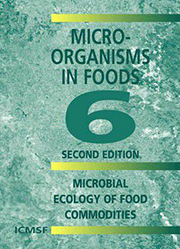
Microorganisms in Foods 6
Microbial Ecology of Food Commodities
2nd edition. A second, further updated edition is published as New York: Kluwer Academic & Plenum Publishers, 2005. ISBN: 0-306-48675-X. Available from Springer. Microorganisms in Foods 6: Microbial Ecology of Food Commodities brings up to date the previous edition (Microorganisms in Foods 3: Vol 2) from 1980 taking account of developments in food processing and packaging, new ranges of products and foodborne pathogens that have emerged since then. Translations are available in Spanish, Portuguese, and Japanese.
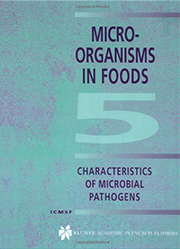
Microorganisms in Foods 5
Characteristics of Microbial Pathogens
Microorganisms in Foods 5: Characteristics of Microbial Pathogens is the only book that examines the characteristics of foodborne pathogens in relation to HACCP. 1996. London: Blackie Academic & Professional. ISBN: 041247350X. Available from Springer. Also published in Spanish by Acribia, Zaragoza, Spain – Manuel Ramis Vergés (translator).
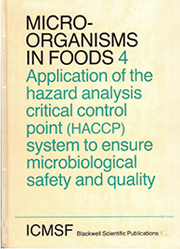
Microorganisms in Foods 4
Application of the Hazard Analysis Critical Control Point (HACCP) System to Ensure Microbiological Safety and Quality
Microorganisms in Foods 4: Application of the Hazard Analysis Critical Control Point (HACCP) System to Ensure Microbiological Safety and Quality was the first complete book devoted solely to the development and implementation of HACCP. 1988. Oxford: Blackwell Scientific Publications. ISBN: 0632021810. Also published in paperback under the title HACCP in Microbiological Safety and Quality, 1988, ISBN: 0632021810. Also translated in Spanish as ICMSF (1988) El sistema de análisis de riesgos y puntos críticos. Su aplicación a las industrias de alimentos, PD Malmenda PD and BM Garcia (translators), Editorial Acribia, Zaragoza, Spain.
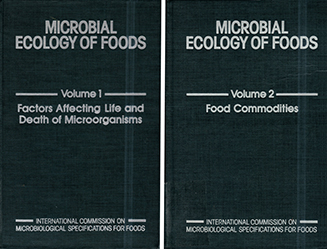
Microorganisms in Foods 3
Microbial Ecology of Foods
Microorganisms in Foods 3: Microbial Ecology of Foods brings food spoilage and health risks into sharper focus through its study of how different food processes, ingredients, and product characteristics affect the microflora of foods. Vol. 1: Factors affecting life and death of microorganisms (ISBN: 0123635012). Vol. 2: Food commodities (ISBN: 0123635020). (1980). New York: Academic Press. Vol. 2 updated as Microorganisms in Foods 6: (above). Also published in Spanish by Acribia, Zaragoza, Spain – Volume 1 translated by J Burgos Gonzalez et al, Volume 2 by B Sanz Perez et al.
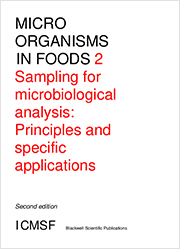
Microorganisms in Foods 2
Sampling for Microbiological Analysis: Principles and Specific Applications
Microorganisms in Foods 2: Sampling for Microbiological Analysis: Principles and Specific Applications is the first comprehensive publication on statistically based sampling plans for foods. 2nd ed. (1986). Toronto: University of Toronto Press. ISBN: 0802056938. Out of print. Part 1 was extensively revised in Book 7 and Part 2 was extensively revised in Book 8. (Note: The original Book 2 has been translated is Spanish by JA Ordonez Pereda and MA Diaz Hernandez MA and published by Acribia, Zaragoza, Spain.)
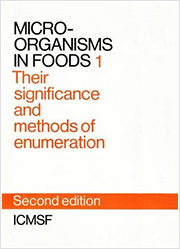
Microorganisms in Foods 1
Their Significance and Methods of Enumeration
Microorganisms in Foods 1: Their Significance and Methods of Enumeration represented a major step in establishing a common understanding of, and developing standard methods for, important foodborne microorganisms. 2nd ed. (1978); reprinted 1982, 1988 with revisions. Toronto: University of Toronto Press. ISBN: 0802022936. Out of print. Also translated by B. Garcia in Spanish and published by Acribia, Zaragoza, Spain.
